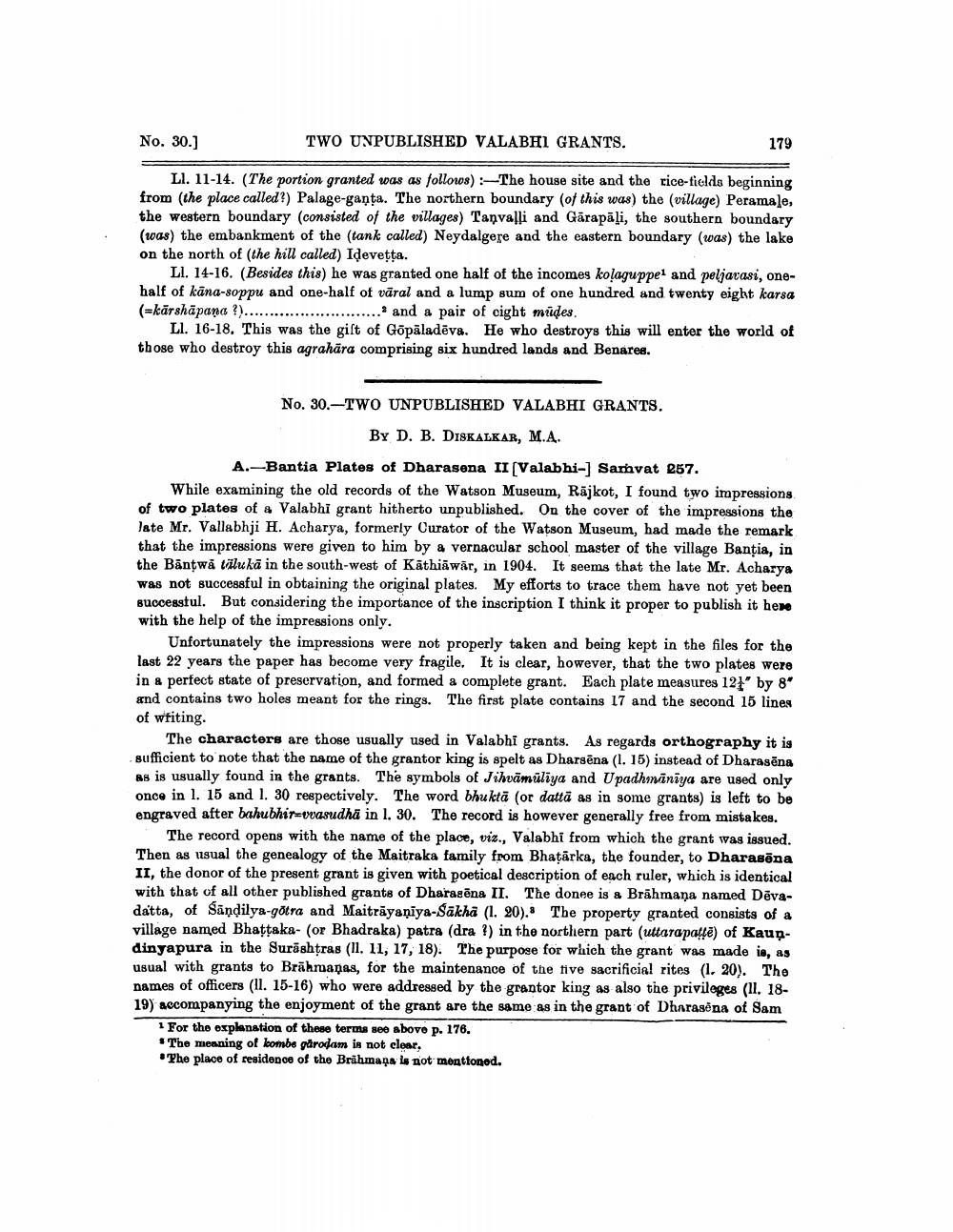________________
No. 30.)
TWO UNPUBLISHED VALABHI GRANTS.
179
Ll. 11-14. (The portion granted was as follows) The house site and the rice-ficlds beginning from the place called?) Palage-ganța. The northern boundary (of this was) the (village) Peramale, the western boundary consisted of the villages) Tanvaļļi and Garapāli, the southern boundary (was) the embankment of the tank called) Neydalgere and the eastern boundary (was) the lake on the north of the hill called) Idevetta.
LI. 14-16. (Besides this) he was granted one half of the incomes kolaguppel and peljarasi, onehalf of kāna-soppu and one-half of vāral and a lump sum of one hundred and twenty eight karsa (=kärshapana ?)........ .........and a pair of eight müdes.
Ll. 16-18. This was the gift of Göpäladēva. He who destroys this will enter the world of those who destroy this agrahāra comprising six hundred lands and Benares.
No. 30.-TWO UNPUBLISHED VALABHI GRANTS.
BY D. B. DISKALKAR, M.A.
A.-Bantia Plates of Dharasena II (Valabhi-] Samvat 257. While examining the old records of the Watson Museum, Rājkot, I found two impressions of two plates of a Valabhi grant hitherto unpublished. On the cover of the impressions the Jate Mr. Vallabhji H. Acharya, formerly Curator of the Watson Museum, had made the remark that the impressions were given to him by a vernacular school master of the village Bantia, in the Bāntwă tālu kā in the south-west of Käthiāwār, in 1904. It seems that the late Mr. Acharya was not successful in obtaining the original plates. My efforts to trace them have not yet been Buccessful. But considering the importance of the inscription I think it proper to publish it here with the help of the impressions only.
Unfortunately the impressions were not properly taken and being kept in the files for the last 22 years the paper has become very fragile. It is clear, however, that the two plates were in a perfect state of preservation, and formed a complete grant. Each plate measures 12' by 8' and contains two holes meant for the rings. The first plate contains 17 and the second 15 lines of wfiting.
The characters are those usually used in Valabhi grants. As regards orthography it is sufficient to note that the name of the grantor king is spelt as Dharsēna (1. 15) instead of Dharasēna As is usually found in the grants. The symbols of Jihvāmüliya and Upadhaniya are used only once in l. 15 and 1. 30 respectively. The word bhuktā (or dattā as in some grants) is left to be engraved after bahubhir=vvasudha in l. 30. The record is however generally free from mistakes.
The record opens with the name of the place, viz., Valabhi from which the grant was issued. Then as usual the genealogy of the Maitraka family from Bhaţārka, the founder, to Dharasõna II, the donor of the present grant is given with poetical description of each ruler, which is identical with that of all other published grants of Dharasēna II. The donee is a Brāhmana named Dēvadatta, of Sandilya-götra and Maitrāyaniya-Sākha (1. 20). The property granted consists of a village named Bhattaka- (or Bhadraka) patra (dra ?) in the northern part (uttarapattē) of Kauņdinyapura in the Surāshtras (11. 11, 17, 18). The purpose for which the grant was made is, as usual with grants to Brāhmaṇas, for the maintenance of the five sacrificial rites (1, 20). The names of officers (II. 15-16) who were addressed by the grantor king as also the privileges (11. 1819) accompanying the enjoyment of the grant are the same as in the grant of Dharasena of Sam
1 For the explanation of these terms see abovo p. 176. * The meaning of lombs parodam is not clear, . The place of residence of the Brāhmana la not mentioned.




